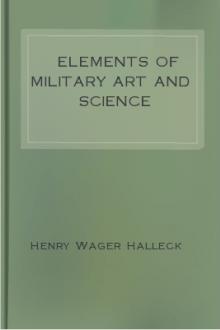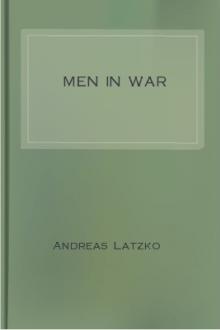Elements of Military Art and Science by Henry Wager Halleck (books you have to read txt) 📕

- Author: Henry Wager Halleck
- Performer: -
Book online «Elements of Military Art and Science by Henry Wager Halleck (books you have to read txt) 📕». Author Henry Wager Halleck
Histoire de la guerre de la peninsule. Foy. This work contains many interesting and valuable remarks on the French and English systems of tactics, and particularly on the tactics of Infantry.
Cours d'art et d'histoire militaires. Jacquinot de Presle.
Art de la guerre. Rogniat.
Instruction destinée aux troupes légères, &c., redigée sur une instruction de Frederick II. à ses officiers.
English Infantry Regulations.
Ordonnance (French) pour l'exercice et les manœuvres de l'infanterie, par le commission de manœuvres.
Aide-mémoires des officiers généraux et supérieurs, et des capitaines.
Essai sur l'histoire générale de l'art militaire. Carion-Nisas.
Histoire de la milice française. Daniel.
Cours élémentaire d'art et d'histoire militaires. Rocquancourt.
Traité élémentaire d'art militaire, &c. Gay de Vernon.
Introduction à l'étude de l'art de la guerre. La Roche-Amyou.
Tactique des trois armes. Decker.
Examen raisonné des trois armes, &c. Okouneff.
The last two are works of great merit. The writings of Okouneff, however, are very diffuse.
Instruction pour le service de l'infanterie légère. Guyard.
Instruction de l'infanterie, &c. Schauenbourg.
Traité de tactique. Ternay et Koch.
Mécanism des manœuvres de guerre de l'infanterie polonaise. Vroniecki.
Traité sur l'infanterie légère. Beurmann.
English Cavalry Regulations.
Ordonnance (French) sur l'exercice et les évolutions de la cavalerie.
Les troupes à cheval de France, &c. De Bourge.
Avant-postes de cavalerie légère. Brack. The author served with distinction under Lassale, Colbert, Maison, Pujol, and Excelmans.
Réflexions sur l'emploi de la cavalerie, &c. Caraman.
Observations sur l'ordonnance, &c., de la cavalerie. Dejean.
Tactique de la cavalerie. Itier.
Eléments de tactique pour la cavalerie, par Mottin de la Balme. A work of rare merit.
De l'emploi de la cavalerie à la guerre. Schauenbourg.
Rémarques sur la cavalerie. Warnery. This work has long enjoyed a high reputation among the cavalry officers of the European services. The Paris edition is enriched with notes by a French general officer.
Nachrichten und Betrachtungen über die Thaten und Schicksale der Reiterei, &c. This work discusses the operations of cavalry in the campaigns of Frederick the Great and of Napoleon, down to the battle of Lutzen in 1813.
Examen du livret provisoire, &c. Marbot.
Le Spectateur Militaire, contains many essays by cavalry officers on the various questions connected with the organization and use of this arm.
Die Gefechtslehre der beiden verbundenen Waffen-Kavallerie und reitenden Artillerie. Decker.
Manuel de l'officier. Ruhle de Lilienstern.
Aide-mémoire, à l'usage des officiers de cavalerie.
Journal de l'infanterie et de la cavalerie.
Traité de tactique pour les officiers d'infanterie et de cavalerie.
Histoire des exploits et des vicissitudes de la cavalerie prussienne. Coutz.
CHAPTER XI.ARMY ORGANIZATION.—ARTILLERY.
Artillery.—Previous to the invention of gunpowder in the thirteenth century, the machines of war were divided between two classes of military men, the engineers (engignours, as they were called in the middle ages) and the artillery, (artilliers, as they were formerly called,) the latter being particularly charged with the management of the lighter and more portable projectile machines, such as the balistas and arco-balistas, which were used for throwing different kinds of arrows—flêches, viretons, carreaux, matras, &c., while the former managed the battering-rams, cranes, helipoles, &c. And, indeed, for a long time after the discovery of gunpowder, this distinction was kept up, and the artillery retained all the more ordinary projectile machines, while the engineers constructed and managed the more ponderous weapons of attack and defence. But the new artillery was gradually introduced, without, however, immediately displacing the old, and there were for a time, if we may be allowed the expression, two artilleries, the one employing the old projectile machines, and the other those of the new invention. The latter were called canoniers, to distinguish them from the former, who still retained the name of artilliers.
The first cannon were invented in the early part of the fourteenth century, or, perhaps, among the Arabs as early as the middle of the thirteenth century, but they were not much known in Europe till about 1350. Cannon are said to have been employed by the Moors as early as 1249, and by the French in 1338. The English used artillery at the battle of Crecy in 1346. Both cannon and the ancient projectile machines were employed at the siege of Aiguillon in 1339, at Zara in 1345, at Rennes in 1357, and at Naples in 1380. At this last siege the ancient balista was employed to throw into the castle of Naples barrels of infectious matter and mutilated limbs of prisoners of war. We read of the same thing being done in Spain at a later period.
Cannon in France were at first called bombards and couleuverines, but were afterwards named from certain figures marked on them, such as serpentines, basilisks, scorpions,&c. In the infancy of the art they were made small, weighing only from twenty to fifty pounds, and were mounted on small moveable carriages. This species of fire-arms became quite numerous about the beginning of the fifteenth century. They were followed by heavier pieces, used in the attack and defence of towns. This siege artillery continued to be increased in dimensions till, towards the latter part of the fifteenth century, they reached such an enormous size as to be almost useless as a military machine. Louis XI. had an immense piece constructed at Tours, in 1770, which, it was said, carried a ball from the Bastille to Charenton, (about six miles!) Its caliber was that of five hundred pounds. It was intended for experiment, and burst on the second discharge. The famous culverin of Bolduc was said to carry a ball from that city to Bommel. The culverin of Nancy, made in 1598, was more than twenty-three feet in length. There is now an ancient cannon in the arsenal at Metz of about this length, which carries a ball of one hundred and forty pounds. Cannon balls were found at Paris as late as 1712, weighing near two hundred pounds, and from twelve to sixteen inches in diameter. At the siege of Constantinople in 1453, there was a famous metallic bombard which threw stone balls of an incredible size; at the siege of Bourges in 1412, a cannon was used which, it was said, threw stone balls "of the size of mill-stones." The Gantois, under Arteville, made a bombard fifty feet in length, whose report was heard at a distance of ten leagues!
The first cannon were made of wood, and covered with sheet-iron, or embraced by iron rings: longitudinal bars of iron were afterwards substituted for the wooden form. Towards the end of the fourteenth century, brass, tin, copper, wrought and cast iron, were successively used for this purpose. The bores of the pieces were first made in a conical shape, and it was not until a much later period that the cylindrical form was introduced.
In the wars between the Spaniards and Moors in the latter part of the fifteenth century, very great use was made of artillery in sieges and battles. Ferdinand the Catholic had at this time, probably, a larger artillery train than any other European power. The Spanish cannon, generally very large, were composed of iron bars about two inches in breadth, held together by bolts and rings of the same metal. The pieces were firmly attached to their carriages, and incapable of either horizontal or vertical movement. The balls thrown by them were usually of marble, though sometimes of iron. Many of the pieces used at the siege of Baza, in 1486, are still to be seen in that city, and also the cannon balls then in use. Some of the latter are fourteen inches in diameter, and weigh one hundred and seventy-five pounds. The length of the cannon was about twelve feet. These dimensions are a proof of a slight improvement in this branch of military science, which was, nevertheless, still in its infancy. The awkwardness of artillery at this period may be judged of by its slowness of fire. At the siege of Zeteuel, in 1407, five "bombards," as the heavy pieces of ordnance were then called, were able to discharge only forty shot in the course of a day; and it is noticed as a remarkable circumstance at the siege of Albahar, that two batteries discharged one hundred and forty balls in the course of the twenty-four hours!
In the Italian wars between France and Spain, in the beginning of the sixteenth century, the difficulty of moving the heavy cannon then in use was so great that only a very small number of pieces were brought upon the battle-field. At the battle of Cerignola, in 1503, the number of cannon in the French army was only thirteen. Indeed, during the greater part of this century, four or five pieces were considered sufficient for an ordinary army in the field, and many agreed to the doctrine of Machiavelli, that the only legitimate use of artillery was in the attack and defence of places. But in the wars of Henry IV. of France, this arm of service was again increased, and the troops which this king destined against the house of Austria had an artillery train of fifty pieces. Great improvements were also made about this period in the manufacture of powder, and all kinds of fire-arms. Sully gave greater development to this arm of service, improving its materials, and increasing its efficiency. Then, as at most other periods, the French were in advance of most other nations in artillery.
It was near the close of the sixteenth or the beginning of the seventeenth century, that the heavy and ill-shaped artillery began to give place to more wieldy and useful pieces. A certain M. de Linar demonstrated, in the latter part of the sixteenth century, that cannon twelve feet in length would give a greater range than those seventeen feet in length, the calibre being the same; but some years elapsed before advantage was taken of this discovery. In 1624, Gustavus Adolphus caused experiments to be made to verify this point, and, on being convinced of its truth, caused his batteries to be furnished with shorter and lighter pieces. This great king introduced, about the same time, a new and lighter kind of artillery, made of sheet iron and leather. Each piece had its chamber formed of thin metal and embraced by strong iron rings; over these was placed a form of hardened leather, which was again encircled with rings and held compactly together. These pieces were mounted on light carriages, so that two men could easily manœuvre them. It was said that they would fire from eight to ten rounds without requiring repairs. Gustavus made use of them in all his military operations from 1628 to the time of his death. They did him excellent service on numerous occasions; being so very light they could be easily transported, and, on the field of battle, their movements could be made to conform to the movements of his troops.
As cannon and small arms were gradually introduced into general use, various inventions and improvements were proposed and introduced from time to time. Cannon were constructed with two or more barrels; some were arranged for being loaded in the breech, and others at the mouth of the piece; two pieces were sometimes connected by horizontal timbers, which revolved about a vertical axis, so that the recoil of one piece would bring the other into battery; and various other arrangements of this description, which have recently been revived and some of them patented as new inventions. The small arms employed at this period were much the same as those used at the present day, except the matchlock, which afterwards gave place to flint-locks. Arms of this description were sometimes made to be loaded at the breach, and guns with two, three, and even as many as eight barrels, were at one time in fashion. In the Musée de l'Artillerie at Paris may be found many arms of this kind, which have been reproduced in this country and England as new inventions. In this Museum are two ancient pieces, invented near the end of the sixteenth or the beginning of the seventeenth century, which very nearly correspond with Colt's patent, with the single exception of the lock![33]
[33]
It is not





Comments (0)